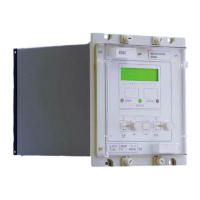Manual
KVCG202/EN M/H
4.8.3 Undervoltage blocking (V<<)
If the system voltage falls below typically 80% Vs, it is necessary to inhibit the relay
‘Raise V’ and ‘Lower V’ outputs. This is needed to prevent operation for fault conditions
on or through the transformer, where the current through the tap changer exceeds the
switching capacity of the tap changer mechanism.
If the voltage falls below the V<< threshold the undervoltage detector will operate and
instantaneously reset the initial time delay thus inhibiting the relay outputs to ‘Raise V’ or
‘Lower V’ tap change operations. This feature may also be used to determine an
operating sequence where a multiple tap change sequence is required to restore nominal
reference voltage, see section 4.4.4 ‘Operating Sequences’.
4.8.4 Overvoltage detection (V>)
The overvoltage detector is set to a threshold which defines the maximum voltage on the
busbars local to the transformer. If the voltage rises above this limit, any tap change
operations that would increase the voltage further are blocked. An independent time
delayed output contact allocated in the Relay Mask ‘V> indicates the operation of the
element. A common time delay t V< V> is used for the V< undervoltage and V>
overvoltage elements.
4.8.5 Overcurrent detection (I
L
>)
If the total load current (IL) through a transformer exceeds the threshold setting, an alarm
is initiated visibly and remotely if the IL> output relay is allocated in relay output mask. If
logic Link [LOG3] is set to ‘1’ then an internal relay will operate blocking both ‘Raise’ and
‘Lower’ operations thus preventing tap changer operation for fault or overload currents
through the transformer. This reinforces the undervoltage blocking previously described.
4.8.6 Undercurrent detection (I
L
<)
If the total load current (IL) through a transformer drops below the threshold setting, an
alarm is initiated visibly and remotely if the IL< output relay is allocated in relay output
mask. If logic Link [LOG8] is set to ‘1’ then an internal software relay will operate
blocking both ‘Raise’ and ‘Lower’ operations thus preventing tap changer operation.
4.8.7 Circulating current detection (IC>)
The circulating current detector (IC>) limits the tap difference between parallel
transformers. The Ic threshold can be set such that it operates when a certain tap
disparity level is reached. In the event of excessive circulating current over a certain
period (tIC), the Ic detector may be used to internally block the relay for both ‘Raise’ and
‘Lower’ operations.
The ‘Ic’ output relay allocated in the Relay Mask will pick up the excessive circulating
current condition to give the alarm indication. If the logic link [LOG2] is set to ‘1’, the
alarm condition will also cause blocking of the tap change control operation.
4.8.8 Reverse current detection (I rev)
If the load current (IL) is in reverse direction, the ‘Irev’ output relay allocated in the Relay
Mask will pick up the reverse current condition to give the alarm indication. If the logic
link [LOG6] is set to ‘1’, the operation of the tap changer will be blocked for a reverse
current. If the logic link [LOG8] is set to ‘1’ then group 2 settings will be selected for a
reverse current.
This feature can be used where embedded generation causes reversal of power flow
through the transformer, see section 4.7.4.3 for more details.
If embedded generation is installed close to the load centre, then this could cause
reduction or possibly reversal of real power flow through upstream transformers.
4.9 Tap position indication
The relay provides an indication of the actual tap position (1 to 40) or (1 to 30) depending
on whether the VT voltage or an external ac voltage supply is used for tap position
indication (TPI). If the system data link [SD9] is set to ‘1’, the TPI is configured to use the

